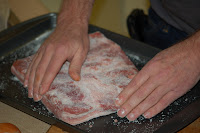 Both of these meats went into our Big Chief Smoker for 8 hours over a hickory chip smoke. Because both of these meats will be cooked fully before eating, the internal temperature of the meat (suggested around 140) is only to ensure the meat takes on the smokey flavour. We don't worry about the temperature preferring instead to taste it as we go.
Both of these meats went into our Big Chief Smoker for 8 hours over a hickory chip smoke. Because both of these meats will be cooked fully before eating, the internal temperature of the meat (suggested around 140) is only to ensure the meat takes on the smokey flavour. We don't worry about the temperature preferring instead to taste it as we go. Then I had a brainstorm. Out on the deck I have had a brisket soaking in corning mixture and it is right on time to eat as corned beef. Well, since the smoker is out, we are making it a pastrami instead.
To do this, you take one corned beef (can be a store bought one if you haven't had time to make it yourself....after all, it has to sit for a minimum of two weeks in the brine to make it "corned"--but really the store bought varietys cannot compare to one you do yourself) and soak it for four hours in cold water. This is to remove some of the salt as the smoking process will condense the flavours and intensify the saltiness. Change the water at least once during this time.
Once you have soaked the beef sufficiently, then make a pastrami rub (there are lots of recipes for this on the web). Here is the basic ingredients: 1/4c kosher or pickling salt, 1/4c paprika, 3 tbsp brown sugar, 8 cloves minced garlic, 3 tbsp black peppercorns, 3 tbsp coriander (seed or powder), 2 tbsp mustard seeds. Grind the peppercorns, coriander (if it is seeds) and mustard seeds into course mix. Add to the rest of ingredients and rub liberally onto the corned beef.
When that is done, put in the smoker until the internal temperature is 165 degrees. This internal temperature ensures that the meat has absorbed as much of the smoke flavour as it can. If your smoker cannot get the temp up that high (like mine) then after about 8 hours in the smoker, put the pastrami in the oven at 325 degrees and cook til a meat thermometer reads 165 degrees internal. This way you are sure to have killed off any nasty bacteria that may have formed during smoking.
Cool the pastrami when done and slice paper thin. For this a meat slicer is best but you can use a very sharp knife.
The one website I read suggested using a very gentle smoke wood such as fruit wood or maple so not to interfere with the flavour of the pastrami. Since we are already doing bacon and it needs a stronger smoke (we are using hickory), we are just going to give it a try for convenience and see. Nothing like a little experimentation to make life interesting.
None of these things are difficult to accomplish. They merely take forethought and planning. The efforts are well rewarded by incredible smells wafting through your home and yard. You might even meet some of your neighbours as they follow their noses to your front door. Not only do you know what is going in to your food, but you have the immense pleasure of saying, YES, I did make this myself.
Enjoy!!!








